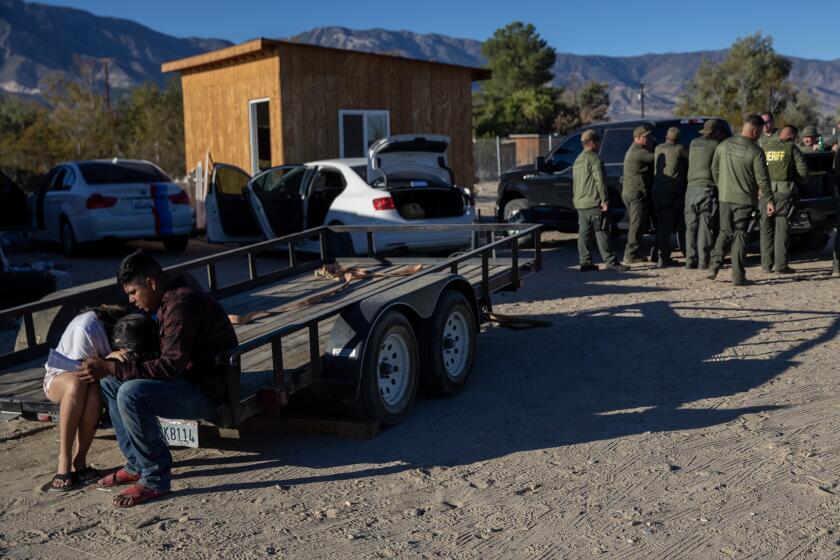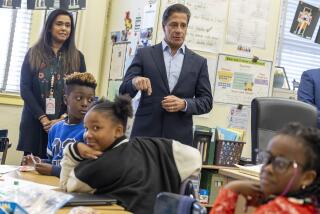Thousands of L.A. students show up for school on first day of winter break

“Acceleration days” — two extra days of school over winter break — were a no-brainer for the brainy Kimberly Sanchez, a senior at the Maywood Center for Enriched Studies. If there had been five extra days, she’d have done them all. She did not need the all-out sales pitch and communication blitz of the last few weeks from school officials urging students to attend.
After a slow start in registrations, about 72,000 Los Angeles students had signed up to be back in the classroom on their first day of winter break Monday, an increase from about two weeks ago when some 45,000 of the district’s 422,276 students had registered and the deadline was removed.
Although actual attendance had not been confirmed — and some teachers reported that many students did not show up — L.A. schools Supt. Alberto Carvalho declared victory, saying the enrollment of 1 in 6 district students surpassed what could be reasonably expected — even though an earlier plan, which was rejected by the teachers union, was set up to attract the majority of students.
Carvalho showcased campuses where the day appeared to be going well, starting off at the Maywood campus, known as MaCES, a grades-six-through-12 school that also was hosting students from Maywood Academy, a nearby southeast L.A. County high school.
The schools chief took on those who questioned the usefulness of the acceleration project — two days this week and two more during spring break are budgeted to cost as much as $65 million.
“If 180 days of schooling is good, then four additional days have to be good,” he added. “But this time around with lower class sizes, with lower ratios of more individualized, personalized attention, looking at what the students are lacking and providing them what they need.”
The alarming dip in math proficiency and smaller declines in English in the last two pandemic-disrupted school years hit students who were already behind.
“We have about 500 students in this school taking advantage of acceleration days,” Carvalho added. Among those, about 250 high schoolers “have an agreement with their teachers. If they submit the number of assignments, their letter grade in their classes will improve. What does that mean? That means that this is an additional chance for these students to graduate on time.”
Tenth-grader Alondra Aguilar, a student from Maywood Academy, wanted to improve her grade in geometry, and she already had assignments from her teacher to complete and turn in online.
“It’s just two days, so it’s like worth it,” she said.
Brianna Rocha, an 11th-grader, had assignments to improve her grade in Advanced Placement psychology. Her parents had nudged her to participate: “They asked me to reach out and ask if I can do anything to better my grade.
“I was already in the habit of getting up early and coming to school,” she said. “But I guess I would have rather stayed in bed.”
Another student, Teylor, a 10th-grader, was hoping to raise his grades in algebra and history, but wasn’t yet sure what he would need to do.
“I think they’re going to tell us in class,” he said.
As he walked off, an announcement over the intercom advised teachers to pick up their “rosters and folders.”
As students entered campus, an administrator handed out candy canes and goldfish crackers, then sent them to a group breakfast in the cafeteria.
Elementary teacher Susan A. Cintigo, who taught mini-lessons and did arts and crafts in between rotations, posted a positive review on a Facebook group for parents and teachers.
“It was great!,” she said. “The kids had fun. They said they will be back tomorrow. ... Plus, it’s extra money in my pocket for Xmas gifts.”
Things were not going smoothly everywhere.
“I got my roster at about 8:40 am, after the attendance system went down and they asked us to take attendance using paper rosters,” one high school teacher reported from a campus in the southern portion of the district. “I have no information beyond student names and grade levels.”
Of more than 20 students on the teacher’s roster, only two materialized, the teacher added.
A teacher elsewhere, who taught unfamiliar students at an unfamiliar campus, called the day a “disaster ... total waste of money.”
At least one school had a significant number of “walk-ons,” who hadn’t signed up in advance. Several teachers reported that many — if not most — of those who signed up failed to show up.
The original plan for the optional acceleration days scheduled them on Wednesdays at strategic points during the academic calendar. That plan required extending the end of the school year by four days. Officials figured more students would take advantage of the special learning time during a regular week.
However, the teachers union, United Teachers Los Angeles, objected, saying the extra days needed to be the subject of labor negotiations. The union filed a legal challenge and also called on teachers to boycott the extra learning time.
District officials capitulated, but also obtained union consent to the backup plan.
The process is an experiment for L.A. Unified. The format varies from school to school and grade level to grade level. Even though teachers union leaders had expressed skepticism, about a third of teachers volunteered to take on the extra days — for which they will be paid. Even nonparticipating teachers had a role to play: They had to decide what and how much work would be necessary for a student to raise a grade, which could mean the difference between passing and failing a class for some.
Carvalho estimated that two-thirds of participating students are those who most need the extra help — although that did not include Kimberly at the Maywood campus, who will be using the time for extra work in AP biology and second-year calculus.
“I need to come to these opportunities and do my part too, because I know that my teachers work hard for me to thrive and for me to get a higher education,” she said. But if I don’t put in my part, there’s no way that I’m going to make it out of here.”
L.A. Reads
L.A. Guides
More to Read
Start your day right
Sign up for Essential California for news, features and recommendations from the L.A. Times and beyond in your inbox six days a week.
You may occasionally receive promotional content from the Los Angeles Times.
















